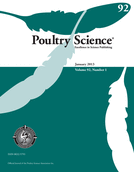View Item
- xmlui.general.dspace_homeCentros Regionales y EEAsCentro Regional Entre RíosEEA Concepción del UruguayArtículos científicosxmlui.ArtifactBrowser.ItemViewer.trail
- DSpace Home
- Centros Regionales y EEAs
- Centro Regional Entre Ríos
- EEA Concepción del Uruguay
- Artículos científicos
- View Item
A comparative study of culture methods and PCR assay for Salmonella detection in poultry drinking water
Abstract
The present work compared 2 culture methods and PCR assays for motile and nonmotile Salmonella detection using artificially contaminated poultry drinking water. The specificity was 1 for all methods studied. The accuracy and sensitivity were 1 for all motile strains, whereas these parameters were between 0 and 0.7 for nonmotile Salmonella strains. The positive predictive value and negative predictive value were 1 for all motile Salmonella strains in the 3
[ver mas...]
The present work compared 2 culture methods and PCR assays for motile and nonmotile Salmonella detection using artificially contaminated poultry drinking water. The specificity was 1 for all methods studied. The accuracy and sensitivity were 1 for all motile strains, whereas these parameters were between 0 and 0.7 for nonmotile Salmonella strains. The positive predictive value and negative predictive value were 1 for all motile Salmonella strains in the 3 methods used. Nonmotile Salmonella strains showed a positive predictive value of 1 in the PCR method. However, the positive predictive value was indeterminate in the tetrathionate (TT) methods for both strains tested and in the modified semisolid Rappaport-Vassiliadis (MSRV) method for Salmonella Pullorum. On the other hand, the negative predictive value was between 0.20 and 0.43 for the 3 methods. The detection level of motile strains was 4 to 7 cfu/25 mL for all methods. Nonmotile Salmonella strains could not be detected in the TT method, whereas only Salmonella Gallinarum could be recovered from 1.1 × 101 cfu/25 mL in the MSRV method. In relation to the molecular methods, PCR could detect these strains from 1.1 × 104 cfu/25 mL. Extending incubation time of the enrichment medium to 6 d in the TT method did not improve the isolation rates. In general, all selective plating media did not show any statistical differences in the parameters of performance studied. The kappa coefficient showed that there was an excellent agreement between the 3 methods for motile strains. For nonmotile strains, the agreement was poor between the MSRV and the PCR; there was no agreement when the TT method was compared with the MSRV and the PCR methods. The difference in detection levels obtained with the methods used for motile and nonmotile Salmonella strains and the difficulty in detecting these last strains represents a potential problem when a poultry water sample is considered negative for the presence of Salmonella.
[Cerrar]

Fuente
Poultry Science 92 (1) : 225–232 (January 2013)
Date
2013-01
Editorial
Oxford Academic Press
ISSN
0032-5791
1525-3171
1525-3171
Formato
pdf
Tipo de documento
artículo
Palabras Claves
Derechos de acceso
Abierto
 Excepto donde se diga explicitamente, este item se publica bajo la siguiente descripción: Creative Commons Attribution-NonCommercial-ShareAlike 2.5 Unported (CC BY-NC-SA 2.5)
Excepto donde se diga explicitamente, este item se publica bajo la siguiente descripción: Creative Commons Attribution-NonCommercial-ShareAlike 2.5 Unported (CC BY-NC-SA 2.5)


